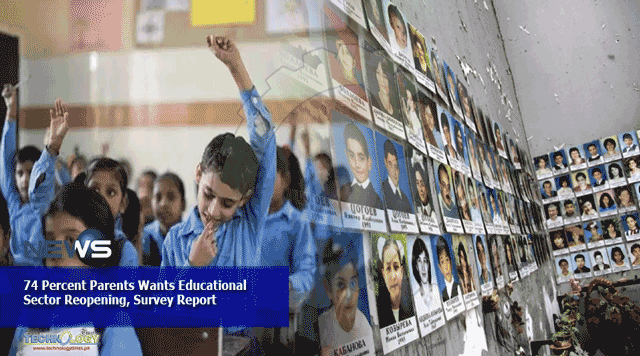A Gallup poll suggests that 74 percent of parents now believe that the curfew on education should be lifted. This was quoted by the federal minister for education, while announcing the council of education ministers meet on July 2 (which was later postponed to July 8) to discuss data, trends and recommendations for safely reopening education.

Meanwhile, without scientific evidence pertaining to such a sensitive matter, the education ministers of the two most populous provinces – Punjab and Sindh – have gone on record to suggest that “no educational institution is opening in Punjab till August 15” while Sindh “will keep education closed till Covid-19 lasts” (which is likely to be years even if a vaccine becomes available on a global scale).
Gut-feel personal views, when expressed by thought-leaders, are dangerously shaping a narrative that is not rooted in science. More importantly, it is preventing: (a) debate on costs and consequences of this education curfew for an entire generation – our 60 million school-age children (including those in pre-school); (b) objective discussion on data-based evidence from numerous countries across the world where schools have reopened; and (c) the way forward on adopting SOPs, recommended by the WHO and UN, tweaked to circumstances in developing countries like Pakistan. Lack of depth in knowledge and understanding prevents costs and consequences of this education curfew, to be visible to those not specialized in education and mental health.
First, Unesco’s recent study suggests that even a few weeks out of school will have a regressive impact on learning outcomes. Consequences are magnified for younger children through added bearing on cognitive behaviour, motor and reasoning skills. Second, a World Bank reported study found that the three-month closure following the 2005 earthquake in Pakistan accumulated learning losses equivalent to 1.5 to 2 years of schooling.
Let this sink in: we are already in the fourth month of closures–- age 5 to 6 pupils have forgotten how to write alphabets; Grade 5 pupils are at Grade 2 learning retention level. Third, research suggests that non-school factors – access, home environment, parental support – are a primary source of inequalities in educational outcomes: the gap between children from lower and higher socioeconomic backgrounds widens, even during relatively short holiday periods.
In Pakistan, this digital and social divide is ‘less than one percent haves’ – those with access to virtual education in top-end private schools, laptop computers for every child at home, unlimited data and independent study spaces. They are the ones, for the most part, making social media noise to keep education closed while also attacking the lack of effectiveness in virtual teaching. The other ‘over 99 percent have-nots’, are those who do not have a voice – but when the latest Gallup survey gave them a voice, the majority pleaded that their children be educated.
Children’s health aspects are even more complicated when seen from the non-visible long-term mental health prism and compared to the visibly scary potential disease risk.
School routines and encouragement are important for young people. Social distancing, missing peer-to-peer dialogue, and lack of attention on celebrating learning progress can result in social isolation and permanent disengagement from formal learning. To examine children’s psychological adjustment, 1784 children from grades 2 to 6, living in Hubei province, were surveyed when schools had only been closed for a month; 22.6 percent reported depression while 18.9 percent reported anxiety symptoms.
Extrapolating this data to the fourth month of closure, and no end in sight, translates into sheer devastation for Pakistani children. To compound this challenge, exacerbated aggression, owing to the inability to support children and adolescents facing bereavement and anguish, is a highly likely outcome from parents facing issues related to stress and anxiety themselves without possessing the skill to cope.
On the disease risk side, the scientific evidence emerging is instructive. First, the mortality rate in young people below 23 years is statistically insignificant. Cambridge University research statistics, when applied to school-going children in Pakistan’s context, translate into increased mortality risk to 17 children out of the 60 million currently out-of-school. Second, Unicef’s health advisory suggests that children, even when infected, show low morbidity and are weak vectors for transferring the disease. This inference is backed by Professor Goosen’s study reporting that children account for less than one percent of infections. Third, recent evidence from Europe, where schools have reopened, shows no statistical correlation between reopening of schools and spike in infection rate or emerging new disease clusters where schools have reopened.
Leading global epidemiologists have, in a recent New York Times poll, voted with a 70 percent majority in favour of reopening of schools. Safe re-opening holds the key to this risk management. The WHO and UN have published guidelines for safe reopening. Pakistan must draw on these and begin to reopen by adopting “globally tried and tested” Standard Operating Procedures (SOPs). What are these SOPs?
Before opening, disinfect campuses; train teachers on SOPs; run a mass awareness campaign for parents to respect SOPs for safety on campuses; ensure that students and teachers arriving have masks on and are, therefore, not exposed in transit.
Focus, however, must remain on following through on SOPs after opening, which has not been the case in other sectors that have opened. These are: daily screening for symptoms; hygiene management; no physical contact games or assemblies; alternating full days with half the grades attending on alternate days; Saturday as a regular working day for the whole academic year to cover the already suffered learning losses; adult visitors put through SOP measures and those faltering being referred to the police.
Tracking is necessary; it should be mandatory to report details of any student absent or sick to the District Health Authority, so that possible patients can continue to be isolated to homes.
This education hostage crisis is destroying the prospects of an entire generation of this country. Rescue them. Let education recommence.
